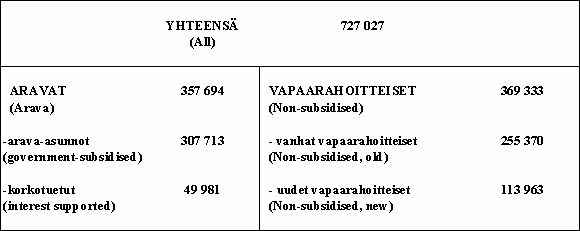Quality Description
- 1. Relevance
- 2. Calculation method
- 3. Framework of quarterly statistics on rents
- 4. Timeliness and promptness of the published data
- 5. Accessibility and transparency of the data
- 6. Comparability of the statistics
- 7. Coherence and consistency
1. Relevance
1.1. Information content
The quarterly statistics on rents describe quarterly and year-on-year levels and changes of rents for the rental dwelling stock. The statistics are published quarterly approximately five weeks after the end of the examined quarter.
1.2. Concepts, classifications and data
1.2.1 The data and the data suppliers
The statistics on rents are compiled from interview data collected in connection with the monthly Labour Force Survey, Statistics Finland’s data on the dwelling stock, obtained from the Building and Dwelling Regis-ter of the Population Register Centre, and data on mi-gration and population structure.
This publication of the quarterly statistics contains information on rents for the whole country, the Greater Helsinki Area, rest of the country, municipalities sur-rounding the Greater Helsinki Area and other largest municipalities. The Greater Helsinki Area comprises Helsinki, Espoo, Vantaa and Kauniainen. The sur-rounding municipalities are Hyvink��, J�rvenp��, Kerava, Riihim�ki, Kirkkkonummi, Nurmij�rvi, Sipoo, Tuusula and Vihti.
The interview data for these statistics have been collected, and the quarterly index calculated since the first quarter of 2003.
1.2.2 Concepts
In these statistics the concept of rent includes separately payable water and heating charges, but not compensa-tions paid for the use of amenities such as sauna or laundry room. Telephone and electricity charges are also excluded. The published average rents have been calculated per square metre of dwelling per month (€/m2/kk).
The concept of number of rooms excludes kitchen. The room number category of 3h+ refers to dwellings with at least three rooms.
An Arava dwelling refers to a dwelling built with a government housing loan, whose rent is determined on the cost coverage principle. Most Arava dwellings are owned by local government. Non-subsidised dwellings are other than Arava dwellings or interest supported dwellings. Rental dwellings receiving interest support are now also classified under gowernment-subsidised dwellings in these statistics.
A new tenancy refers to a tenancy that has started within less than 12 months from the reference month of a Labour Force Survey interview. For example, in the interview data of December 2008, new tenancies mean those that commenced on or after 1 January 2008.
2. Calculation method
The calculation method used for these quarterly rent statistics is a combination of a traditional method based on classification and a regression analysis (hedonic method).
The data of the rent statistics are classified by area, type of financing, duration of tenancy and number of rooms. The classification is based on the NUTS2 re-gional division that entered into force in 2003. The data within the NUTS2 areas are classified by region and major town. Division in type of financing is made into non-subsidised and government subsidised tenancies. Non-subsidised tenancies are further classified into old and new tenancies. The formed categories are finally classified by number of rooms (1h, 2h, 3h+).
Regression model

where subindex i refers to the estimation category, j to the observation number and k to the municipality or postal code area within the category. Ln(pij) is the loga-rithmic price per square meter for dwelling i in area j. Variables Aijk are micro-area indicators (postal code areas with large towns and municipality indicators with combined areas). Kaksio (duplex) and kolmio (triplex) are room number indicators and rivitalo (terraced house) is house type indicator. The variable uusi (new) indicates new tenancies.
The index of rents is calculated with the following Laspeyres formula:
Laspeyres


is the average price standardised for quality for category i in the comparison period,

is the category-specific index calculation weight and

is the average base period price for category i. The average prices are geometric averages.
The weights of the index calculation have been de-termined using data on dwelling stock and on population structure. The weight is the summed-up floor area of rental dwellings in a category.
3. Framework of quarterly statistics on rents
Framework of quarterly statistics on rents

4. Timeliness and promptness of the published data
The annual rent statistics are published four times in a year and the published data are final.
5. Accessibility and transparency of the data
A latest data release from the statistics and an electronic pdf version of the publication will be published on Statistics Finland’s website on the publication date of the quarterly statistics on rents.
6. Comparability of the statistics
Besides quarterly, Statistics Finland also publishes statistics on rents annually. The compilation of the quarterly statistics deviates in certain respects from that of the annual statistics. The clearest difference between the two sets of statistics is that in addition to interview data, the annual statistics also utilise data from the Housing Allowance Register, which are not used in the quarterly statistics. Thus, the basis of the data for the annual statistics is considerably broader than the one for the quarterly statistics.
7. Coherence and consistency
Apart from the statistics compiled by Statistics Finland, no other regular data are produced on rents of dwellings in Finland. Statistics Finland publishes annual and quarterly statistics on rents.
Source: House Rents, Statistics Finland
Inquiries: Martti Korhonen +358-9-17343451, Paula Paavilainen +358-9-17343397
Director in charge: Kari Molnar
Updated 6.11.2009
Official Statistics of Finland (OSF):
Rents of dwellings [e-publication].
ISSN=1798-1018. 3rd quarter 2009,
Quality Description
. Helsinki: Statistics Finland [referred: 5.1.2026].
Access method: http://stat.fi/til/asvu/2009/03/asvu_2009_03_2009-11-06_laa_001_en.html

